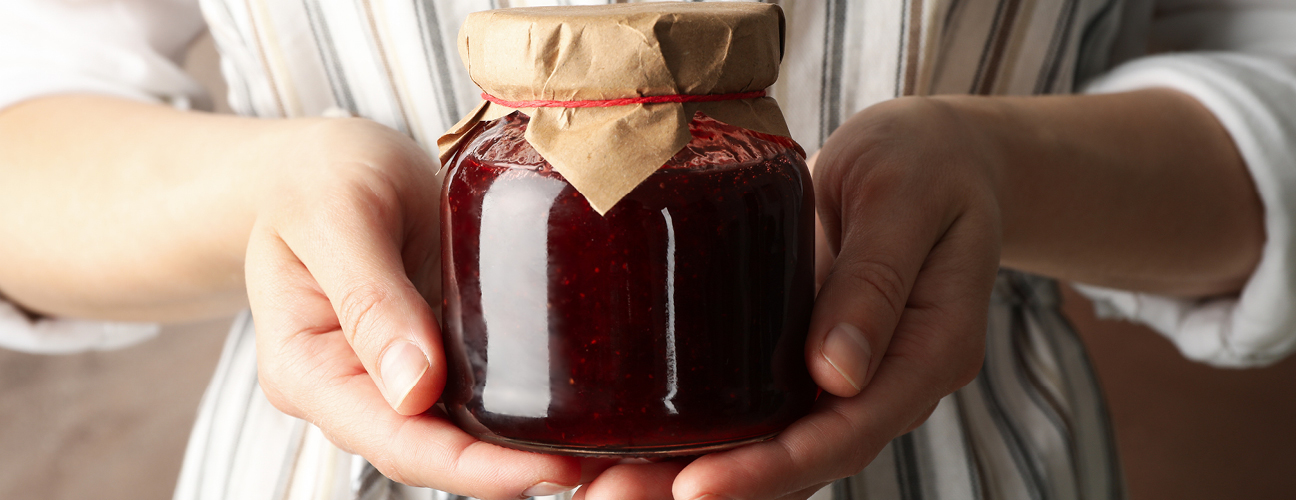Our guide to … making jam

With the abundance of berries and stone fruit available at the moment, now is the time to make jam. This can sound daunting or only something that 1950s housewives did – not true! With our tips you’ll be making jam like a CWA lady in no time.
There’s nothing better than a dollop of homemade jam on a scone with some double cream. It’s the height of the berry and stone-fruit season in Tasmania and there’s a lot of wonderful fruit around.
All you need is about 1.5kg of fruit, an equal amount of sugar, some lemon juice and water in varying amounts, depending on which fruit you are using, and you’re in business.
First sterilise your jars
This is easy and can be done using your oven. This is an essential step or you might have mould or bacteria growing in your jam jar – not what you want! Read our easy tip for sterilising jam jars here.
Next prepare your fruit
De-stalk and de-stone your fruit and wash it. The exception to washing is soft berries like raspberries, blackberries and blueberries – they will retain too much water. Then weigh your fruit – the weight specified in recipes is without stalks and stones. Halve and then chop stone fruit.
Weigh your sugar
Generally jam is made with equal parts sugar to fruit. So if you have 1.5kg of prepared fruit, weigh out 1.5kg of white sugar.
The role of pectin
Pectin is a soluble fibre (polysaccharide) present in fruits. It is the substance which allows jam to set. Some fruits are high pectin (citrus, currants, quinces, crab-apples), some are medium (apricots, blackberries, raspberries, plums, peaches, blueberries, apples) and some are low pectin (strawberries, pears, cherries, rhubarb, nectarines). Lemon juice helps release pectin, so that’s why you will see recipes include lemon juice – it aids in the setting of the jam. For extra pectin you can add a muslin pouch of lemon rind and pips.
Your pot and other equipment
There are specialised jam kettles which are wider at the top, allowing greater evaporation. But any large, heavy-based saucepan will do the job – something that you would make soup in will be the right capacity. Other useful equipment is a wide metal funnel (without one, you will need to be REALLY accurate when ladling out the hot jam – very difficult and messy), and a metal soup ladle. Oven mits are a good idea to handle the hot jars.
Cooking the jam
Place your fruit, and the amount of lemon juice and water your recipe specifies, into your pot and stew over medium heat until the fruit is soft. Add the sugar and bring it all to the boil, ensuring you continue stirring throughout to stop it catching on the bottom of the pan.
The key is to not overcook your jam or you will lose the character of the fruit and its wonderful colour. You want to boil it until it reaches setting point and no longer. Skim off any foam rising up with a slotted spoon – this will help make the jam clear and jewel-bright.
How to determine setting point
After boiling for some time the jam will begin to look thicker and the colour still vibrant but slightly darker, and glossy. The fruit should be soft but still holding its shape. Get a saucer, drop a teaspoon of jam on to it and place in the fridge. Within a minute or two the jam will cool and will form a slight skin which will pull or wrinkle when you lightly drag a finger or end of the wooden spoon through it. If this happens, your jam has reached setting point and is ready to take off the stove.
If you have a sugar thermometer, setting point will be reached at 105C.
Jar your jam
Pour into warm sterilized jars (ideally with the help of a ladle and funnel). Be careful, the jam is lava hot and will burn you. Mits are a good idea. Seal immediately and label.
Storage
Jam will keep in a cool dark place for up to a year. It can be eaten as soon as it cools. Once you open a jar, keep it in the fridge to prevent mould forming.
Recipes to try
Try your hand at any of Sally Wise’s recipes in her book A Year in Bottle. Sally is the undisputed queen of jams and preserves in Tasmania. She specifies for apricot, nectarine or peach jam, to use 1.5 kg fruit, 1.5 kg sugar, juice of two lemons and ¾ cup of water. For her strawberry jam, use 1.5 kg fruit, 1.5 kg sugar, juice of two lemons, and ¼ cup of water.
Or try these recipes for nectarine jam and plum jam from Hill Street’s recipe collection.

